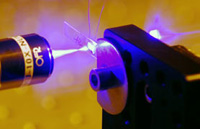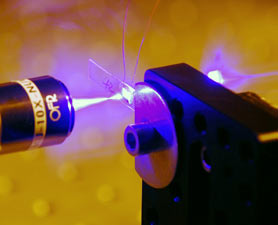Th e microrobots could have a range of applications from studying the environment to spying on extremists.
e microrobots could have a range of applications from studying the environment to spying on extremists.
Power-producing piezoelectric materials are now getting smarter thanks to the work of scientists from Georgia Tech.
The new, so-called "piezotronics" could be lead to a new class of intelligent, self-powered microrobots, which have a range of applications from studying the environment to spying on extremists.
Power-producing piezoelectric materials are now getting smarter thanks to the work of scientists from Georgia Tech.
The new, so-called "piezotronics" could be lead to a new class of intelligent, self-powered microrobots, which have a range of applications from studying the environment to spying on extremists.
"This is the first time that a mechanical action has been used to create a logic operation," said Z.L. Wang, a researcher at Georgia Tech and co-author of a series of reports in Nano Letters, Advanced Materials and elsewhere detailing his recent advances in piezotronics.
When bent, twisted or otherwise stressed, piezoelectric materials generate an electrical charge. Usually the charge is mild; most piezoelectric materials can only generate millivolts worth of electricity, which isn't enough to power most consumer electronics.
However, over the last year or so several groups, including Wang's, have created piezoelectric devices that can generate significantly more electricity. Woven into clothing or other materials, those higher energy piezoelectric materials could one day power electricity-hungry devices, such as cell phones, laptops and implanted medical devices.
Wang's piezotronic devices are made from relatively cheap and easy-to-manufacture zinc oxide formed into thin nanowires or microscopic pyramids. When moved back and forth, these tiny structures generate a small electrical current.
Wang's innovation is to incorporate a gate into the wires or pyramids that regulates the current. If a current isn't strong enough, it will not be transmitted. This simple on/off switch could act like a 0 or 1 in a computer to add an additional layer of information.
By combining energy generation and simple computation, piezotronic devices could reduce the size and weight of microrobots.
These tiny devices could travel to remote places and relay information about environmental conditions, or environmental contaminants, back to its operator.
Microrobots could also have defensive applications. Slipped into a room and equipped with a microphone, a microrobot would be virtually invisible but could eavesdrop on the conversations of criminals or extremists.
Piezotronic devices could also be added to armor plating, providing soldiers or law enforcement personal with information about what, and where, an attack is coming from.
The new research is "impressive and pretty clever," said Michael McAlpine, a scientist at
"Zinc oxide is not the most efficient piezoelectric out there, but one of the nice things about it is that it is also a semiconductor," said McAlpine. Instead of one system harvesting power and one performing logic operations, Wang's design can perform both functions.

 Previous page
Previous page Back to top
Back to top







